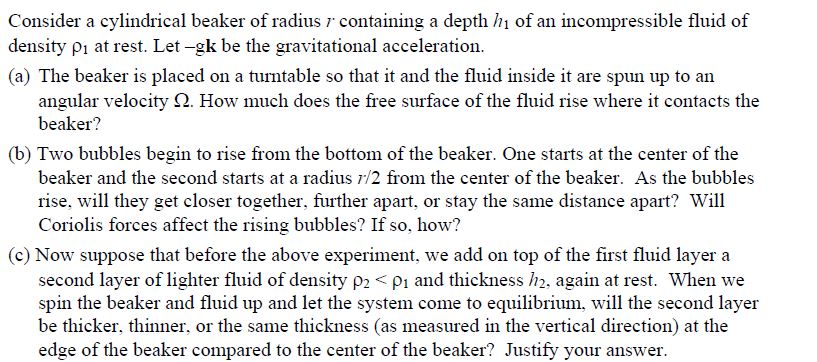Physics 410/510 Third Homework Assignment
Due in class Wednesday December 2
When working out the numerical problems, make sure you use a
consistent set of units.
1. It has been empirically esablished that the growth rate
of deposition nuclei can be expressed as:
ND = bSia
Where Si = the supersaturation percentage of air (i.e.
101) and b and a are constants. ND is the number of ice
nuclei per cubic meter.
Experimentally b = 0.13 and a ranges from 3 to 8.
From this empirical relationship, specify the combinations of Si
and a that are required to produce ND = 100 and 10,000,000
respectively. Also provide
a graphical representation of your solutions
2. Calculate the times taken for water drops of radii 1, 10 and
100 microns to fall a distance of 1 km in air at terminal velocity.
Take the air viscosity to be 2 x10-5 kg m-1 s-1
In the case of the largest droplet (where you should find a fall time
of 10 minutes) comment on why this calculation is incorrect.
3. Suppose that Mt. St Helens blows and that ash particles are blown
to a height in the stratosphere where the pressure = 50 mb. Assume
the tropsphere starts at a pressure of 200 mb. The ash particles are
spherical with a mean radius of 0.1 microns and a density of
2600 kg m-3, Estimate the time it takes for these
particles to reach the earth's surface.
4. Get the data table from The Official El Nino Monitoring Site . The data consist of 3 month averaged index values for each month of the year going back to 1950.
Using any data analysis tools that you want, try and identify if there is a characteristic time scale associated with the appearance of el nino events (those are the ones with red numbers). In addition, on a per decade basis, determine the number of strong El NIno months, where strong means values greater than or equal to 0.9
5. The Eugene Rainfall Anamoly:
Compute monthly amounts of rainfall for each month since 1950 and answer the following questions:
- Produce a smoothed wave form of the annual precipitation for both Salem and Eugene from 1950 to now and comment on any differences between these wave forms.
- Correlate the Eugene and Salem monthly totals and comment on any anamolies that you notice.
- Compare the winter time precipitation at both sites where Winter is defined as the 4 consecutive months of November, December, January and February over the time internal 2000 to now
and 1950 - 2000 and comment on any trends you might see.
Additional Problem for the Grad Students
6.
 HINT: HINT:

|